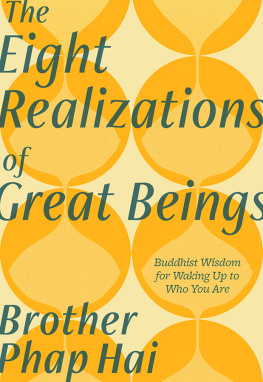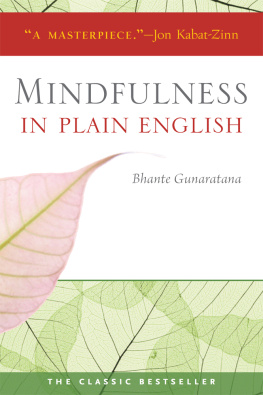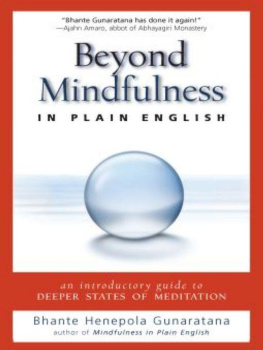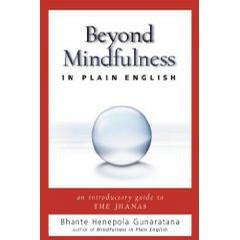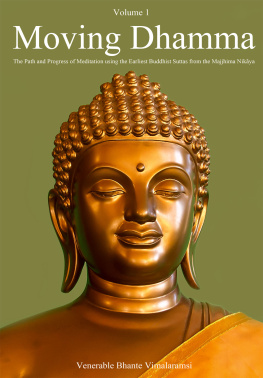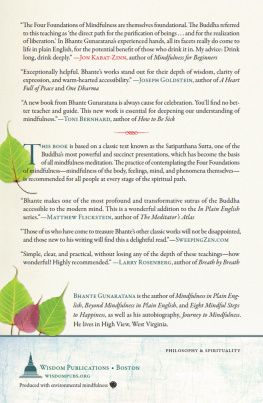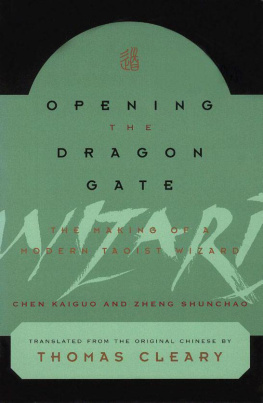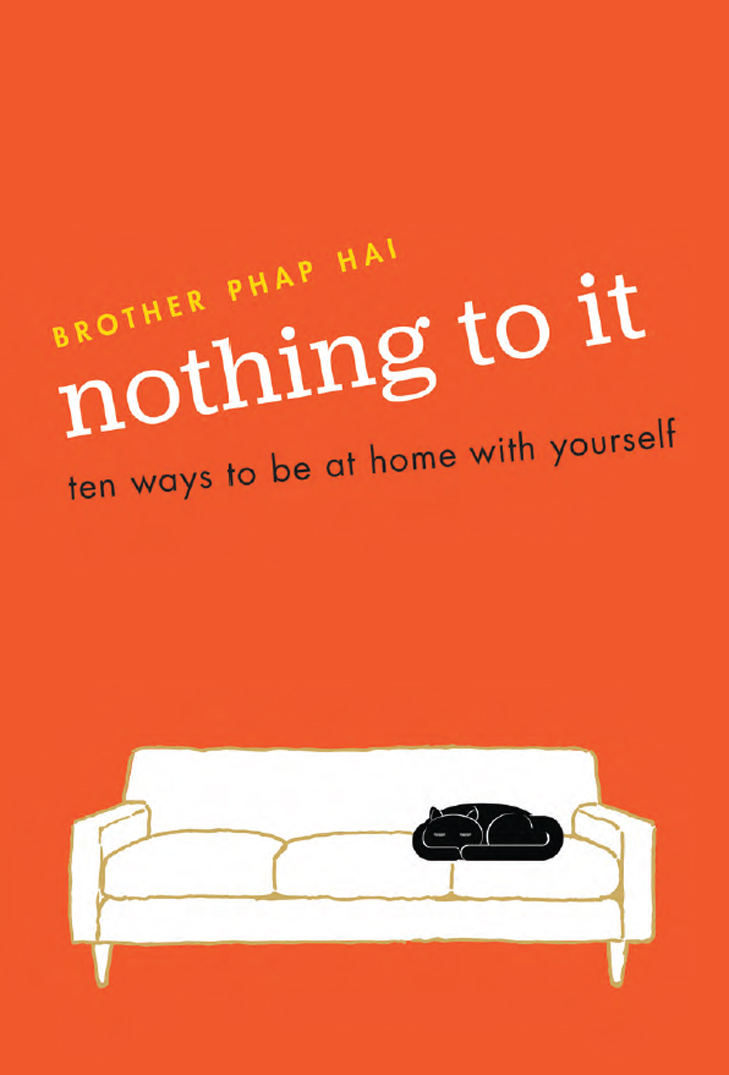

To my great teacher, Thay Thich Nhat Hanh, and to all of my monastic familythank you from the bottom of my heart.
Contents
Guide
Id like to begin by stating for the record that I never planned to write a book. It just sort of happened. Well, thats not true entirely. Being an inherently lazy person, if I had known just how much blood, sweat, and tears go into each page of a book, then I dont think I would ever have begun. This book began as a series of talks, one each week, that I gave during the annual winter retreat of 20122013 at Deer Park Monastery in California, which were offered as a structured learning course for friends at home who wished to follow along with the three-month retreat. While being very dedicated practitioners, many friends lead very busy lives, and wish for a way to bring the winter retreats spirit of focused learning and practice into their lives, since it would be well-nigh impossible for them to step away from their responsibilities for three months.
Each week of our retreat started with a forty-five minute talk on a particular theme, and included readings, suggested practices, and questions that practitioners at home could reflect on, alone or together with a Sangha or group of practitioners for discussion. In fact, many Sanghas throughout the United States and around the world followed along, listened to the podcast, and used the reflection questions as topics for group discussions.
It was my intention to create an atmosphere of intimacy and informality through having these sharing sessions: I wanted participants to feel as though we were chatting together as good spiritual friends. The great teacher Shantideva is reported to have said, Everything I want to say has already been said, and I am destitute and poor of expression. A truer thing has never been said with regard to me and to my teaching. Many wonderful meditation manuals, sutra commentaries, and technical books on Buddhism exist, but this small volume does not pretend to be any of those things. It is not as much of a how to as it is an invitation to just do.
I intend this book to be like a kind spiritual friend who will take your hand and walk with you on your path, wherever you find yourself in this moment. I invite you to take a chapter each week and read it slowly over the course of a few days, allowing the words to sink into your being. In the same way as on a formal retreat, Ive provided suggested readings, practices, and questions for reflection in each chapter. You will find it helpful to have a notebook handy to write down your insights and reflections as we move through these next weeks together.
Each year, the Buddhist monastic community holds a three-month retreat in which we focus all of our time and energy into our spiritual life. It is a time when we also concretely experience the beauty of the Sangha jewel, the gift of community, one of the Three Jewels of Buddhist practice. The Rains Retreat, as it is called, is a central practice of Buddhist monastic communities in all traditionsTheravada, Mahayana, and Vajrayana. Its so central that when we ask each other how long weve been ordained, we dont reply, Ten years or Five years or One year, we say, Ive completed x number of Rains Retreats.
Traditionally, since the time of the Buddha, the Rains Retreat has been held in Asia in the summer months when the monsoons bring heavy rain, and its very difficult to travel around; naturally, our focus turns somewhat more inward. Especially in Europe, and also in North America, where Im currently sitting, the summertime is a really easy and wonderful time to travel around. Individuals and families find it easy to come to the monastery, and we go out to offer retreats and Days of Mindfulness throughout the country. The wintertime is when its rainy or snowy and its cold and difficult to travel around. Therefore, in the Plum Village tradition, we hold our annual Rains Retreat in the winter, usually beginning in mid-November and ending in mid-February.
Theres a great need for structured learning and practice. Through this humble book, I offer an opportunity to those of us who dont live near a practice center to encounter the depth, the simplicity, and the beauty of focused practice. Each of the ten chapters is a heart-reflection on some of the core teachings of Buddhism and contains suggested practices. I suggest you dedicate some time on your calendar toward your own self-retreat. While its not necessary to stick to a strict schedule, I suggest that you move through this book slowly, one chapter a week, either for your own personal practice or with a group of friends, in person or online.
As we practice over the next ten weeks, let us be aware that were not practicing in isolation, even though it might seem so at this moment if you are sitting by yourself. An important part of our annual Rains Retreat is the opening ceremony, when we declare the physical boundaries of the space that we will be practicing in, and when we take refuge in each other for the duration of the retreat.
In a monastic setting, during the Rains Retreat we dont set foot outside the physical limits of our community. The outer physical boundaries that we choose to remain within help us to focus on whats really necessary and most important. They help us to develop focused attention, to release our scatteredness, and to let go of a lot of our busyness. Its so easy to get carried away with any number of different things that we think are crucially important to do now, and, despite the best of intentions, we get carried away from what we most wish to do, which is to live our lives deeply and meaningfully. But the outward boundaries dont mean much if our minds are still running around here, there, and everywhere. The presence of outer boundaries facilitates an inner process of letting go and the deepening of a sustained personal practice.
At the very beginning of this journey, the very beginning of our time together, consider your own situationwherever you might be, and whatever you might be doing, what your focus of attention might be as you work through the reflections and exercises in this book. What is the clutter that is filling up your spaceboth outer space and inner space?
What are the outer boundaries that we might find helpful to declare for ourselves? For example:
During these next few weeks Im not going to spend four hours a day watching TV.
In October and November Im going to take a walk every lunchtime and practice walking meditation every day.
From New Years Day until the first day of spring Im going to commit to meditate every day.
What are some of the inner boundaries you might find helpful to declare for yourself? Some examples might be:
I recognize that I get caught up in self-judgments and judgments of others. During this period of practice, when I notice that habit energy arising, I will breathe deeply, smile, and let go.
I notice that I am often worried or anxious. During these weeks, I will consciously practice to bring myself back to the wonderful present.
I would advise you not to try to be too ambitioustwo or three intentions are probably more than sufficient for most of us.
Not so long ago, my teacher Thich Nhat Hanh, whom we call Thay (teacher) according to Vietnamese tradition, gave a very beautiful teaching to the monastic residents of our community, in which he shared the importance of creating a dynamic balance in our spiritual life. He talked about our spiritual life as being composed of four aspects: study, practice, work, and play. When we live in a balanced way, these four areas form a harmonious pattern or mandala of practice in our daily lives.


